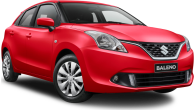Built by Kia in South Korea, the Ford Festiva is a tough little car that seems to just keep on keeping on.
After a successful 10 years on the Australian market that began in October 1991, the Ford Festiva was succeeded by the Ford Fiesta at the end of the year 2000. While the two names continued to be mistakenly intermingled to this day, the two machines are significantly different.
The first Festivas were virtually identical in appearance to older Mazda 121s, except that the Ford was sold as a three or five-door hatchback and the Mazda only as a three-door.
From January 1993 the Festiva was sold new as either a three-door hatch, called the Trio, or a five-door hatch. Three-door models are noticeably shorter than the five-doors so are a bit cramped in the back seat. However, boot space is similar in both bodies.
As a city car for people with no real interest in driving the Festiva works nicely.
Festivas from April 1994 are based on mechanical components from the later Mazda 121, the one with the nickname of ‘bubble car’.
There were minor Festiva facelifts in January 1997 and, only a year later, in January 1998, but neither made any real difference to the appearance or character of the car.
Handling is not particularly good as the Festiva's suspension and steering are too soft. Ford Australia specified better tyres as part of the import deal but many subsequent owners seem to have later opted for cheaper rubber. Keen drivers will be frustrated by too much understeer and a tendency for the car to be knocked off line by bumps if it’s being hurried along. Fiestas are much better and will be the subject of another used-car feature.
As a city car for people with no real interest in driving the Festiva works nicely. It’s easy to drive and park and offers good front seat space and headroom, even for very tall adults. You wouldn’t call it a family car, but owners with preteen children it works well enough. Naturally, most buyers are singles or couples without kids.
The Festiva's seats aren’t particularly good for long trips, being on the flat and shapeless side. If you plan to use one for long holiday runs try to have a decent test drive before deciding to buy it. Ride comfort is not too bad but refinement in the pre-1994 cars isn’t as good as in the later series.
Spare parts are well priced and sold through one of the largest dealer networks in the country. While there are plenty of Ford dealers in country areas these are likely source Festiva parts from head office rather than keep them in stock.
However as Festivas age fewer and fewer bits are likely to be kept by dealers you might have to contact recyclers for parts. Mazda dealers and recyclers may also be able to help with bits. It’s smart to do some research on this in your home area before going to deeply into the purchase of a Festiva.
A good home mechanic can do most of their own repairs on these small Fords, but underbonnet space is at a premium so expect to draw blood from knuckles at times. Having a workshop manual standing by before tackling anything more than minor work makes a lot of sense.
Insurance premiums are generally towards the lower end of the scale, reflecting the basic nature of the Festiva and the fact that few are driven hard.
Festiva was withdrawn from the Australian market late in 2000, though a few won't have been registered for the first time until 2001. Make sure you buy the car for a 2000 price as the build date is accepted as defining a car’s age, not the date of first registration.
Though Ford Australia lost the right to import the car, Kia continues to sell a later model, that are now known as the Rio, so it’s worth having a look at them as well.
What to look for
Festiva bodies are generally well built, however interior quality can be variable. Look for things that aren't fitted securely and listen for rattles and squeaks on bumpy roads during your test drive.
Rust may get into the lower areas of the doors, tailgate, door sills and mudguards. Check also around the fuel filler cap.
Check for wear in the interior, especially if the car looks to have been trashed by kids in the back seat.
The boot may have been knocked around by luggage that hasn’t been properly stowed.
Smoking exhausts are not unusual in high mileage Festivas, it’s normally at its worst when the car is accelerated under load after it has been idling for more than about a minute. Look for oily stains on the bodywork around the tailpipe and around the oil filler cap.
Gearboxes may crunch on fast third-to-second-gear downchanges. The problem may simply be clutch adjustment, but get a proper diagnosis before buying a car as the ‘box is relatively expensive to repair.
Be sure the car pulls up squarely under hard braking, with no one wheel locking up before the others.
Car buying tip
Small cars often lead harder lives than larger ones, frequently being used in harsh city and suburban environments. Don’t let low kilometre readings cloud your judgement.
Ford Festiva 1991:
| Engine Type | Inline 4, 1.3L |
|---|---|
| Fuel Type | Unleaded Petrol |
| Fuel Efficiency | 7.2L/100km (combined) |
| Seating | 5 |
| Price From | $2,420 - $3,850 |
Verdict
How Much?
Given their age Ford Festiva prices only range from $1000 to $3000.
Car buying tip
Small cars often lead harder lives than larger ones, frequently being used in harsh city and suburban environments. Don’t let low kilometre readings cloud your judgement.










.jpg)





































.jpg)







.jpg)
.jpg)

Comments